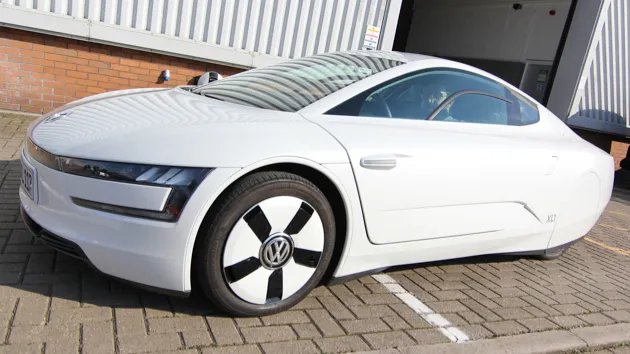313 miles. That’s how far Volkswagen claims its new car, the XL1, will take you on just one gallon (4.5l) of fuel. If you set off from London, it would cost you around £6.50 to get to the Scottish border (using petrolprices.com as a guide). More importantly, this figure of 313 mpg means that the XL1 is the most economical car that money can buy. We travelled to VW’s headquarters ahead of the car’s UK launch to find out just what makes it so frugal.
What is it like in person?
The XL1 has been built in the singular pursuit of economy. Funnily enough, this translates into a pretty good-looking car.
The goal of the XL1’s design is to have a body that pushes as little air out of way as possible, meaning that the engine’s workload is minimised. As a result, the car has an extraordinarily low profile, while the front of the car is moulded into a shape that bears a passing resemblance to a shark’s nose. That’s not just a coincidence – sharks are aerodynamic. Since they’re constantly swimming in a dense fluid, nature has streamlined them to require as little effort as possible to move around.
But back to the XL1. Any air that the car does push out of the way is channeled into a small crevice at the rear. The idea is that the airflow tucks in behind the car, actually providing a little propulsion in the process. The wheels are after-dinner-mint-thin too, reducing friction, and the side-view mirrors are replaced with cameras to keep everything streamlined. Altogether, this makes for one of the most aerodynamic cars on the road.
Inside, the story is much the same. There are few luxuries, though the lightweight racing seats are surprisingly comfy. There is a slot for a Garmin sat nav-cum-multimedia device, but when you consider the crash diet the XL1 has been through, it almost seems decadent to plug it in. In fact, even my pudgy frame started to feel like it was adding too many kilos to the equation. This feeling worsened when I heard that the XL1 only weighs 795kg.
The XL1 is a hybrid vehicle - a dinky 800cc diesel engine and a spritely electric motor share the power duties. Together, they create 68 brake horsepower. It’s not a figure to boast about, but it doesn’t need to be. At 60mph, the XL1 only needs eight of those horses to maintain its speed.

What is it like to drive?
Surprisingly fun. The XL1 isn’t a fast car, and despite its supercar styling, it’s not meant to be. That said, you do feel remarkably connected to the road – your rump is barely off the ground, the car is incredibly light, and there’s no power steering. Unusually for such a lightweight car, the ride’s not bad either.
What's more, something starts to happen as you eat up the miles. As the car constantly swaps between the electric and diesel motors to give you more range, you start to sympathise with its efforts, shifting the way you drive to try and help it achieve its 313 mpg goal. You coast longer, take your foot off the gas earlier, and accelerate more gently.
To test the XL1’s aerodynamical prowess, I turned onto a straight road – about a mile in length – took the car up to 60mph, and released my foot from the gas. I travelled the whole length of the road, only losing 20mph of speed on the way - the car just glided, like it was on ice. It’s so unlike any other driving experience that you start to toy with it, just to see how little you need to touch the accelerator.
And that’s the real trick. While the XL1’s engineering means it can hit 313 mpg, it needs you, the driver, to drive in such a way that will help it reach that figure. This is perhaps the first car I’ve driven that really motivates you to change your habits behind the wheel.
Can I buy one?
Well, probably not at the moment. The initial production run is only 250 cars, and I imagine most of those are snapped up already. You’ll also need a fairly healthy bank account to afford one, as the XL1 is priced at £98,515.
But if you can’t get your hands on one, don’t worry. Volkswagen says that many of the lessons learned while making the XL1 are already feeding into its cars of the future.
Follow Science Focus onTwitter,Facebook, Instagramand Flipboard
